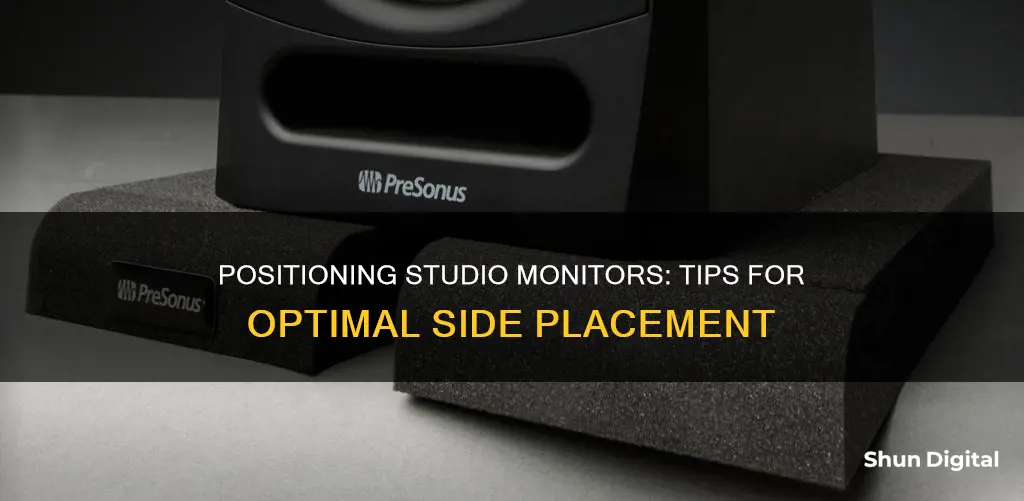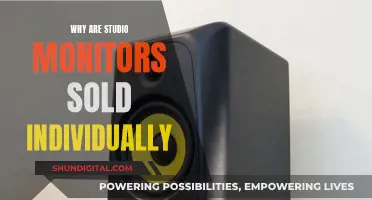
There are several reasons why studio monitors should not be placed on their sides. Firstly, it can disrupt the stereo image, causing strange and unstable sound output. Secondly, it can affect the accuracy of sound reproduction, with different frequency components of a specific sound source appearing to come from different places. Thirdly, it can result in comb-filtering due to phase cancellation, leading to unwanted colouration and inaccurate sound. Lastly, it can impact the bass response and cooling efficiency of the monitors. However, in certain cases, placing studio monitors on their sides may be necessary due to space constraints or to minimise interruption from main monitors.
What You'll Learn

Stereo image will suffer
When studio monitors are placed on their side, the stereo image will suffer. This is because the tweeter and bass driver are no longer aligned vertically, which means that the sound from each driver will reach the listener at different times. This results in a strange, unstable, and disconnected stereo image, where the different frequency components of a specific sound source will appear to come from different places.
The stereo image is also affected by the horizontal and vertical dispersion patterns of the speakers. Most speakers have a wide horizontal dispersion angle to maximise the stereo image width and 'sweet spot' listening area, but a narrow vertical dispersion to minimise surface reflections off the console or work surface and ceiling. When the speaker is turned on its side, the dispersion characteristics are reversed, resulting in a narrower 'sweet spot' and stereo image, and worse surface reflections. This, in turn, leads to more colouration, comb filtering, and other unwanted effects.
The stereo image can also be affected by the placement of the bass driver. In most cases, the bass driver is mounted some distance from the bottom of the cabinet. When the speaker is placed on its side, the bass driver ends up much closer to the mounting surface than intended, which can result in changes to the frequency response through the bass region.
Overall, placing studio monitors on their side will result in a narrower stereo image and a less accurate sound.
Refurbished Monitors: Worth Buying or Wasteful?
You may want to see also

Sound will become more coloured and less accurate
When studio monitors are placed on their side, the sound becomes more coloured and less accurate. This is due to the vertical alignment of the tweeter and bass driver in most speakers. When the speaker is turned on its side, the sound from the two drivers arrives at the listener's ears at different times, resulting in a strange and unstable stereo image. The different frequency components of a specific sound source appear to come from different places, and it becomes difficult to reproduce a stable centre phantom image.
The issue of colouration is further exacerbated by the crossover region, where both drivers are reproducing the same signals. The different path lengths from each driver to the listener result in a comb-filtering effect due to phase cancellation, leading to inaccurate and coloured sound. This colouration varies significantly as the listener moves left and right from the central listening position.
Additionally, most speakers are designed with a wide horizontal dispersion angle to maximise the stereo image width and 'sweet spot' listening area. By turning the speaker on its side, the dispersion characteristics are reversed, resulting in a narrower 'sweet spot' and increased surface reflections. This, in turn, leads to more colouration, comb filtering, and other unwanted effects.
It is important to note that some speakers are designed to be placed on their sides, usually involving specific tweaks such as turning the tweeter waveguide around. However, for most studio monitors, placing them on their side will result in a less accurate and more coloured sound output.
Finding Android Device Monitor in Android Studio
You may want to see also

Bass driver placement will be affected
When placing studio monitors on their side, the bass driver placement will be affected. The bass driver is usually mounted some distance away from the bottom of the cabinet. When the speaker is placed on its side, the bass driver will be closer to the mounting surface than intended in the original design. This can result in changes to the frequency response through the bass region, and the performance of the speaker will deviate from what the designer intended.
The bass driver and tweeter are usually aligned vertically in conventional speaker designs. This is so that the sounds from each driver reach the listener at the same time. When the speaker is turned on its side, the sound from the two drivers will reach the listener at different times. This can result in a strange, unstable, and disconnected stereo image, where the different frequency components of a specific sound source will appear to come from different places.
Additionally, in the crossover region where both drivers reproduce the same signals, the different path lengths from each driver to the listener will result in a comb-filtering effect due to phase cancellation. This will cause the sound to become coloured and inaccurate. This effect will also vary as the listener moves left and right from the central listening position.
The bass driver placement will also be affected by the distance of the speaker from the walls of the room. In general, studio monitors should not be placed against walls, especially corners, as this will create issues in the lower end of the spectrum. This is especially relevant for rear-ported monitors, where the port that allows air from the woofer to escape is situated at the back. Reflections off the walls can cause phase cancellations and other unwanted acoustic interactions.
Therefore, it is recommended to maintain a minimum distance of 20-30 cm (8-12 inches) between the monitors and walls, which is generally enough to reduce sound waves reflecting back to the listening position. A maximum distance of 60-90 cm is also suggested. The distances between the monitors and the side and back walls should be different to avoid creating corners in the listening position.
Monitors: Rapid Growth to Full Size, How Quick?
You may want to see also

Cooling efficiency will be impacted
While it is possible to place studio monitors on their side, it is not recommended as it can negatively affect cooling efficiency. Many powered monitors have finned cooling heatsinks on the rear panel that are designed to channel cold air up the vertical fins, like a chimney. When the monitor is placed on its side, the airflow is disrupted and becomes turbulent, reducing cooling efficiency. This can lead to potential overheating, which can cause protection shutdowns in the short term and premature component failure in the long term.
The impact on cooling efficiency is due to the disruption of the airflow pattern that the heatsinks are designed to create. When placed vertically, the heatsinks allow air to flow up and away from the monitor, keeping it cool. When placed on its side, the airflow is disrupted, and the heatsinks may not be able to dissipate heat effectively.
Additionally, the amplifier pack in studio monitors heats up with active use, and placing the monitors on their side can further impact the cooling process. The combination of reduced airflow and heat from the amplifier can lead to overheating and potential damage to the components.
To ensure optimal cooling efficiency, it is best to follow the manufacturer's recommendations for placement and orientation of the studio monitors. Proper airflow and heat dissipation are crucial for the long-term performance and longevity of the equipment.
It is worth noting that some speakers are designed to be used on their side, usually involving specific tweaks such as turning the tweeter waveguide around. However, for most studio monitors, it is recommended to place them vertically to maintain proper cooling efficiency and overall performance.
In summary, placing studio monitors on their side can impact cooling efficiency due to disrupted airflow and increased heat from the amplifier. To ensure optimal performance and longevity, it is best to follow the manufacturer's placement guidelines and maintain proper airflow for adequate cooling.
Removing FPS Counter: ASUS VG245H Monitor Guide
You may want to see also

Reflections off the console or work surface will increase
When studio monitors are placed on their side, the dispersion characteristics of the speakers are reversed. This results in a narrower 'sweet spot' and stereo image, and increased surface reflections.
Most speakers are designed with a wide horizontal dispersion angle and a narrow vertical dispersion angle to maximize the stereo image width and 'sweet spot' listening area. The 'sweet spot' refers to the ideal placement of the listener and monitors, where the listener is located at one point of an equilateral triangle and the monitors are located at the other two points, angled towards the listener. By turning the speaker on its side, the dispersion characteristics are reversed, resulting in a narrower 'sweet spot' and stereo image. This means that the listener has less flexibility in their listening position, and any movement will result in a more dramatic change in sound quality.
In addition, the increased surface reflections caused by turning a speaker on its side can result in more colouration, comb filtering, and other unwanted effects. Acoustically hard surfaces, such as windows, drywall or plaster walls, mirrors, and any non-absorptive, nondiffusible surfaces, reflect sound in the same way that a mirror reflects light. When the direct sound from the speaker combines with a reflected sound, the sound is altered, a phenomenon known as comb filtering. Placing studio monitors on their side can increase the amount of sound that is reflected off the console or work surface, leading to more comb filtering and a degradation in sound quality.
To avoid these issues, it is generally recommended to follow the manufacturer's recommendations for placement and to use monitor stands or isolation pads to separate the monitors from the console or work surface.
Renewed Monitors: Worth the Money or Risky Business?
You may want to see also
Frequently asked questions
Studio monitors are designed to function best when placed either vertically or horizontally. However, placing them on their side can disrupt the stereo image and cause sound colouration and reflection issues. It is best to follow the manufacturer's recommendations for placement.
When studio monitors are placed on their side, the tweeter and bass driver are no longer aligned vertically. This causes the sounds from each driver to reach the listener at different times, resulting in a disconnected stereo image where different frequency components seem to come from different places.
Yes, placing studio monitors on their side can also cause issues with cooling, frequency response, and stability. The bass driver may be placed closer to the mounting surface than intended, affecting the bass response. The cooling heat sinks on the back of active monitors may also be impacted, reducing airflow and causing overheating.







